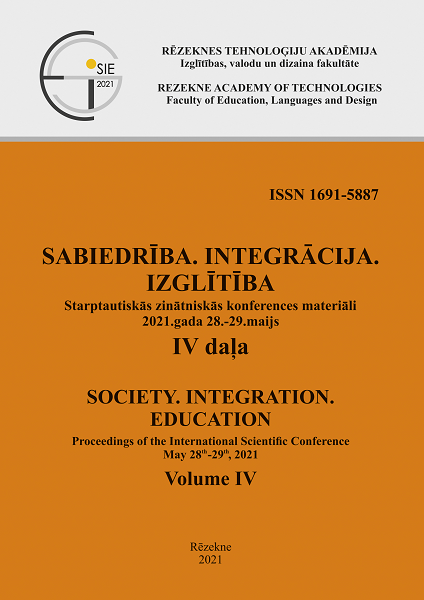THE IMPORTANCE OF EDUCATION TO REDUCE SELF-DESTRUCTIVE NAIL HABITS
DOI:
https://doi.org/10.17770/sie2021vol4.6418Keywords:
onychophagia, onychotillomaniaAbstract
Onychophagia and onychotillomania are rarely seen in clinical practice and are considered undervalued. The study aims were to determine the prevalence of onychophagia and onychotillomania habit in the patient group with hand nail damage and control group, to determine which would be the target population to educate. Patients were interviewed about self-destructive habits. Excel and SPSS were used for data analysis. In the nail damage group, 28.6% of the respondents showed self-destructive habits and past habits – 31.4%. In the control group, the result was 22.9% and 31.4%. For 74.3% of patients the cause of nail damage was skin disease (including 61.54% of respondents with nail damage who have psoriasis), for 5.7% it was age-related nail changes, for 20% traumatic damage and for 57.14% of them it was a result of self-destructive habit. In the nail damage group both – present and past self-destructive habits are higher than in the control group, but it has no statistical significance (p=0.785). 1)The prevalence of onychophagia and onychotillomania does not differ between patients and control group. 2)General education of the population is necessary to actualize this problem, which can worsen nail changes.
References
Alkiewicz, J. (1934). Uber onychotillomania. Dermatol Wochenschr, 98, 519-521
Bakwin, H. (1971). Nail‐biting in Twins. Developmental Medicine & Child Neurology, 13(3), 304-307. DOI: https://doi.org/10.1111/j.1469-8749.1971.tb03265.x
Ergun, A., Toprak, R., & Sisman, F.N. (2013). Impact of a healthy nails program on nail-biting in Turkish schoolchildren: a controlled pretest-posttest study. Journal of School Nursing, 29(6), 416-424. DOI: https://doi.org/10.1177/1059840513481386
Fernandes, G., Franco-Micheloni, A. L. úci., Siqueira, J. T. T. esserol., Gonçalves, D. A. parecid. G., & Camparis, C. M. ari. (2016). Parafunctional habits are associated cumulatively to painful temporomandibular disorders in adolescents. Brazilian Oral Research, 30(1), 1807-3107. DOI: https://doi.org/10.1590/1807-3107BOR-2016.vol30.0015
Gras-Ozimek, J., Ozimek, W., Kozińska, U., Gras-Graupera, M., Kozińska, E., & Bar, A. (2019). Ascariasis and its relationship with selected psycho-neurological symptoms among children and adults in Poland. Polski Merkuriusz Lekarski, 46(274), 165-171
Gupta, M. A., & Gupta, A. K. (2019). Self-induced dermatoses: A great imitator. Clinics in Dermatology, 37(3), 268-277. DOI: https://doi.org/10.1016/j.clindermatol.2019.01.006
Halteh, P., Scher, R. K., & Lipner, S. R. (2017). Onychophagia: A nail-biting conundrum for physicians. Journal of Dermatological Treatment, 28(2) 166-172. https://doi.org/10.1080/09546634.2016.1200711
Haneke, E. (2013). Autoaggressive Nail Disorders. Dermatología Revista Mexicana, 57(4), 225- 234.
Houghton, D. C., Alexander, J. R., Bauer, C. C., & Woods, D. W. (2018). Body-focused repetitive behaviors: More prevalent than once thought? Psychiatry Research, 270, 389–393. DOI: https://doi.org/10.1016/j.psychres.2018.10.002
Kang, S., Amagai, M., Bruckner, A. L., Enk, A. H., Margolis, D. J., Mcmichael, A. J., & Orringer, J. S. (2019). Nail disorders. In E. Haneke (Ed), Fitzpatrick’s Dermatology (1-86). Pennsylvania: McGraw-Hill.
Maraz, A., Hende, B., Bert Urban, R., & Demetrovics, Z. (2017). Pathological grooming: Evidence for a single factor behind trichotillomania, skin picking and nail biting. PLoS ONE, 12(9), 1-13. DOI: https://doi.org/10.1371/journal.pone.0183806
Marouane, O., Ghorbel, M., Nahdi, M., Necibi, A., & Douki, N. (2016). New Approach to Managing Onychophagia. Case Reports in Dentistry, 2016 (11), 1-5. DOI:https://doi.org/10.1155/2016/5475462
Pacan, P., Grzesiak, M., Reich, A., Kantorska-Janiec, M., & Szepietowski, J. C. (2014). Onychophagia and onychotillomania: Prevalence, clinical picture and comorbidities. Acta Dermato-Venereologica, 94(1), 67–71. DOI: https://doi.org/10.2340/00015555-1616
Pacan, P., Reich, A., Grzesiak, M., & Szepietowski, J. C. (2014). Onychophagia is associated with impairment of quality of life. Acta Dermato-Venereologica, 94(6), 703-706. DOI: https://doi.org/10.2340/00015555-1817
Reddy, S., Sanjai, K., Kumaraswamy, J., Papaiah, L., & Jeevan, M. (2013). Oral carriage of enterobacteriaceae among school children with chronic nail-biting habit. Journal of Oral and Maxillofacial Pathology, 17(2), 163-168. DOI: https://doi.org/10.4103/0973-029X.119743
Sagi, L., Trau, H. (2011). The Koebner phenomenon. Clinics in Dermatology, 29(2), 231-236. DOI: https://doi.org/10.1016/j.clindermatol.2010.09.014
Shetty, S. R., & Munshi, A. K. (1998). Oral habits in children--a prevalence study. Journal of the Indian Society of Pedodontics and Preventive Dentistry, 16(2), 61–66
Solley, K., & Turner, C. (2018). Prevalence and correlates of clinically significant body-focused repetitive behaviors in a non-clinical sample. Comprehensive Psychiatry, 2018(86), 9-18. DOI: https://doi.org/10.1016/j.comppsych.2018.06.014
Winebrake, J. P., Grover, K., Halteh, P., & Lipner, S. R. (2018). Pediatric Onychophagia: A Survey-Based Study of Prevalence, Etiologies, and Co-Morbidities. American Journal of Clinical Dermatology, 19(6), 887-891. DOI: https://doi.org/10.1007/s40257-018-0386-1
Wu, A. G., Lin, K., Cooley, V., Lipner, S. R. (2021). A cross-sectional study of onychotillomania and onychophagia in graduate students. In Dermatologic Therapy,34(1), 1-2. DOI: https://doi.org/10.1111/dth.14639
Zisova, L., Chokoeva, A., Sotiriou, E., Valtchev, V., Gospodinov, D. (2015). Onychomycosis and children - A multicenter study. Acta Medica Bulgarica, 42(1), 23-33. DOI: https://doi.org/10.1515/amb-2015-0004






